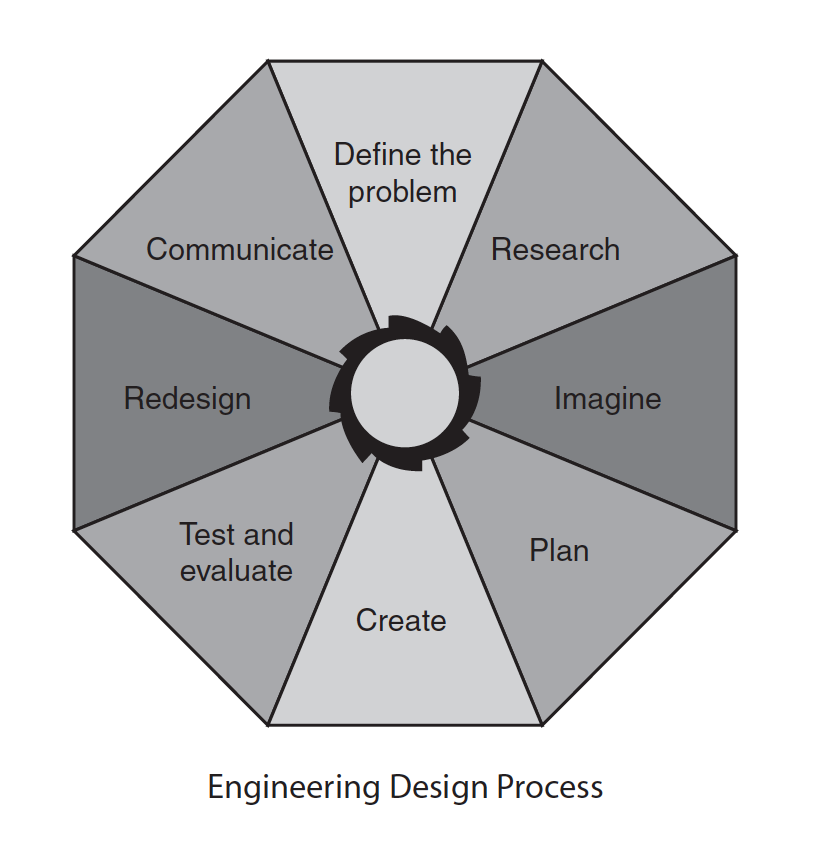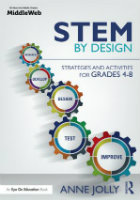A MiddleWeb Blog
 You may be familiar with maker spaces. In one form or another, hands-on teaching has always involved kids in “making.” Today’s new focus on maker spaces is taking making to a whole new level.
You may be familiar with maker spaces. In one form or another, hands-on teaching has always involved kids in “making.” Today’s new focus on maker spaces is taking making to a whole new level.
Visualize a space filled with an assortment of materials and tools where people explore ideas together, create, and invent. Now think of such a space existing in a school – a space where students can go to imagine, investigate, figure things out, and design prototypes. Sylvia Martinez and Gary Stager explain this growing school phenomenon in their MiddleWeb article, Maker Schools: Classroom Tinkers & Inventors.
Personally, I like to think of maker spaces as spots that fuel curiosity-driven learning – engaging spaces that nurture your students’ curiosity and creativity. Just think how productive your STEM lessons would be if they were driven by student curiosity!
Before reading on, note that maker spaces are not intended to substitute for STEM projects. For example, intentionally applying specific grade-level math and science content knowledge is not necessarily part of a maker project; however, it is a critical component of STEM challenges.
 On the other hand, maker activities and STEM lessons do overlap in useful ways. The maker component can help to generate enthusiasm and interest for an upcoming STEM challenge, and it also dovetails nicely with parts of the engineering design process that call for students to research, imagine, plan, and create.
On the other hand, maker activities and STEM lessons do overlap in useful ways. The maker component can help to generate enthusiasm and interest for an upcoming STEM challenge, and it also dovetails nicely with parts of the engineering design process that call for students to research, imagine, plan, and create.
Blend making activities with STEM lessons
To blend making activities with STEM lessons, start by leading kids to identify real world questions, issues, or problems they are interested in solving.
To be sure that the STEM problem helps kids apply specific grade-level science and math objectives, plan to guide them in brainstorming and choosing suitable challenges. Pages 37-40 of my STEM by Design book can help you with selecting appropriate real-world problems. But you don’t have to buy the book. Visit my STEM by Design site for these tips.
 http://www.middleweb.com/wp-content/uploads/2016/09/k-j-3-girls-w-kids-in-bkgr-300x177.jpg 300w" sizes="(max-width: 570px) 100vw, 570px" />
http://www.middleweb.com/wp-content/uploads/2016/09/k-j-3-girls-w-kids-in-bkgr-300x177.jpg 300w" sizes="(max-width: 570px) 100vw, 570px" />
Next, set aside a day for kids to do nothing but tinker with materials and invent possible solutions. Give them space and freedom to muck about and try out their own ideas. Innovative and off-the-wall ideas are welcome! That brings up the matter of how to create a maker space that produces a stimulating environment for your STEM projects. You may want to tackle a few logistics as you consider that.
- A maker space location. Where can students explore materials, design, create, and brainstorm? This may be in your classroom or lab, or even in the school library. Some schools have dedicated design labs (lucky!). You can locate ideas for how to set up maker spaces by typing maker space into a search engine, or by searching sites such as Pinterest. (Check out the pins at https://www.pinterest.com/makemagazine/.)
 http://www.middleweb.com/wp-content/uploads/2016/09/j-k-3-boys-helmet-320-300x232.jpg 300w" sizes="(max-width: 320px) 100vw, 320px" />Basically, just grab the largest space you can access. Hopefully, tables are available, but if not, let kids work in the floor or pull desks together. Provide baskets, tubs, or other storage containers of materials. Don’t worry if the area gets messy, but do enlist students to help straighten it up after the making session. Think of this space as a learning lab for kids – a place where they can check out their own ideas for possible solutions.
http://www.middleweb.com/wp-content/uploads/2016/09/j-k-3-boys-helmet-320-300x232.jpg 300w" sizes="(max-width: 320px) 100vw, 320px" />Basically, just grab the largest space you can access. Hopefully, tables are available, but if not, let kids work in the floor or pull desks together. Provide baskets, tubs, or other storage containers of materials. Don’t worry if the area gets messy, but do enlist students to help straighten it up after the making session. Think of this space as a learning lab for kids – a place where they can check out their own ideas for possible solutions.
You may want your students to work in a virtual maker space as well. They could then share their ideas and questions in a wider maker community. They might access some online sites such as MakerSpace. (You can set up a free account there for them to use from school.) They could also showcase their work on Instagram and Twitter (#MakerEdSpace is a place some kids use for that purpose.)
- A variety of materials and tools. Be sure that some items in your maker space will work well to help students design a solution for the problem, but there’s no set list of equipment. Include other types of items as well to spark ingenuity. Start with items you have on hand (junk is good!). Those may consist of aluminum foil, tape, scissors, paper, paper cups, chenille stems, craft sticks, etc. I generally go to a store that sells inexpensive items like coffee filters, netting, glue, clay, paper towels, etc., and gather up a number of items. Also consider going to a craft store or a hardware store and gathering up items such as tubing, fasteners, and a variety of enticing odds and ends. If you send home a list of some items you need with students, chances are parents will donate many of these.
 Provide available technologies such as computers, tablets, smart phones, and even science equipment. Once the kids are armed with their questions or problems, step back and give them the freedom to tinker, explore, and create. Encourage them to make pictures or sketches of designs they want to turn into prototypes. (Also check out Kevin Jarrett’s Edutopia posts about creating a middle school design lab.)
Provide available technologies such as computers, tablets, smart phones, and even science equipment. Once the kids are armed with their questions or problems, step back and give them the freedom to tinker, explore, and create. Encourage them to make pictures or sketches of designs they want to turn into prototypes. (Also check out Kevin Jarrett’s Edutopia posts about creating a middle school design lab.)
- A plan to keep students purposeful. Sometimes kids seem stuck and unable to make progress. Provide just enough guidance to encourage students and keep them involved in generating ideas and creating possible solutions. Questions such as “I wonder how I could build a (fill in the blank) with some of these materials?” might help them to come up with ideas. Rather than giving them hints about an answer or a solution for a problem, encourage them to find information (perhaps from others or online) that can help them come up with ideas for solutions.
- A focus on developing persistence. Determination and resolve are two of the most valuable qualities kids of any age can develop. When students come up with ideas that don’t work the first time (or the first several times, for that matter) cheer them on. That’s okay. In fact, that’s even good! Engineers seldom get it right the first time, either, but they keep on trying until they get it right. We learn and grow more from our failures than from our successes.
 To sum it up: In schools, maker spaces are engaging areas for students to explore their own ideas for solving problems and to gather input from other students. Your STEM lessons are driven by real-world engineering challenges coupled with supporting science, mathematics and technology skills. Yet, maker spaces can play an important role in creating energy, enthusiasm, and student innovation as they imagine new possibilities.
To sum it up: In schools, maker spaces are engaging areas for students to explore their own ideas for solving problems and to gather input from other students. Your STEM lessons are driven by real-world engineering challenges coupled with supporting science, mathematics and technology skills. Yet, maker spaces can play an important role in creating energy, enthusiasm, and student innovation as they imagine new possibilities.
Additional ideas on maker spaces that your parents might like can be found at Reinvent Summer Learning: Make It Up!
Idea! Encourage your librarian to create a maker space in your school media center: A Librarian’s Guide to Makerspaces: 16 Resources
Photos: Kevin Jarrett, Flickr Creative Commons
_________________________________________________
 Anne Jolly’s new book, STEM by Design: Strategies and Activities for Grades 4-8, is published by Routledge/Eye On Education, in partnership with MiddleWeb. Receive a 20% discount with code MWEB1 at the Routledge website.
Anne Jolly’s new book, STEM by Design: Strategies and Activities for Grades 4-8, is published by Routledge/Eye On Education, in partnership with MiddleWeb. Receive a 20% discount with code MWEB1 at the Routledge website.
From the Amazon description: “This practical book…has all the answers and tools you need to get started or enhance your current program. Based on the author’s popular MiddleWeb blog of the same name, STEM by Design reveals the secrets to successful lessons in which students use science, math, and technology to solve real-world engineering design problems.”
You need to be a member of School Leadership 2.0 to add comments!
Join School Leadership 2.0